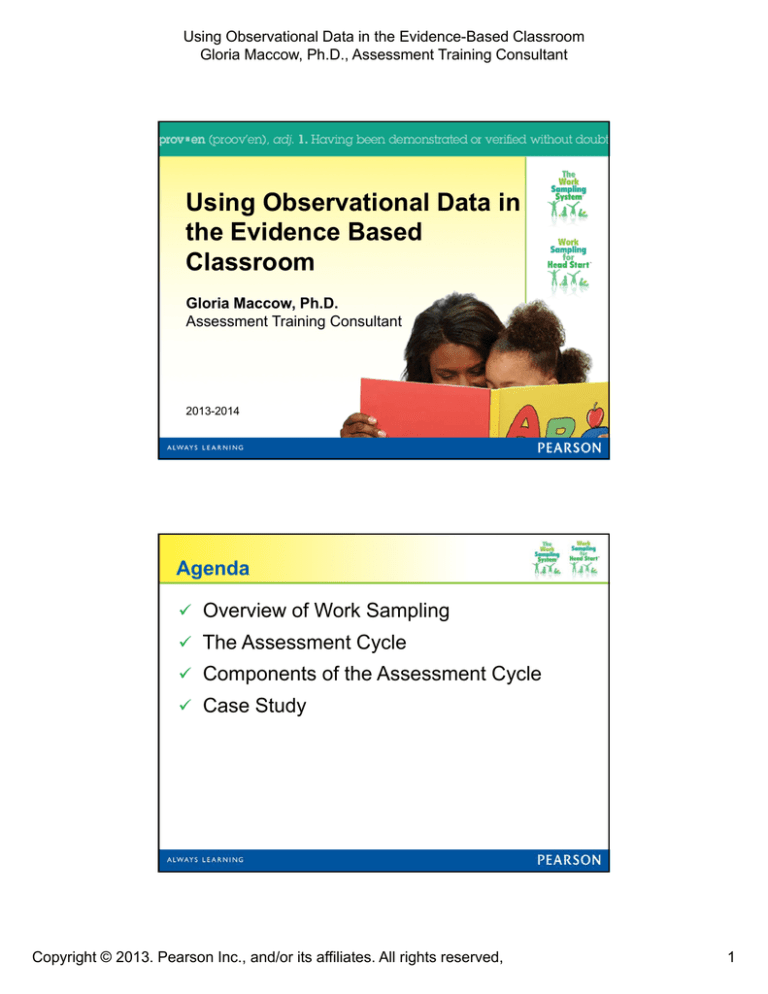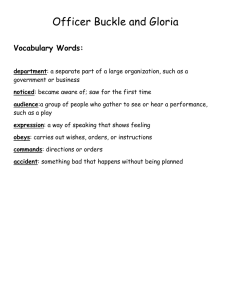
Using Observational Data in the Evidence-Based Classroom
Gloria Maccow, Ph.D., Assessment Training Consultant
Using Observational Data in
the Evidence Based
Classroom
Gloria Maccow, Ph.D.
Assessment Training Consultant
2013-2014
Agenda
Overview of Work Sampling
The Assessment Cycle
Components of the Assessment Cycle
Case Study
Copyright © 2013. Pearson Inc., and/or its affiliates. All rights reserved,
1
Using Observational Data in the Evidence-Based Classroom
Gloria Maccow, Ph.D., Assessment Training Consultant
Overview of
The Work Sampling System
What is Work Sampling?
•
Authentic Performance Assessment
•
Curriculum Embedded
•
Instructional Assessment
•
Ongoing Evaluation
Copyright © 2013. Pearson Inc., and/or its affiliates. All rights reserved,
2
Using Observational Data in the Evidence-Based Classroom
Gloria Maccow, Ph.D., Assessment Training Consultant
Authentic Performance Assessment
Work Sampling helps teachers:
use actual
classroom
experiences,
activities, and
products
to document
and evaluate
children’s
skills,
knowledge,
and behaviors
Curriculum Embedded Assessment
Work Sampling enables teachers to:
learn about their students by encouraging them to
show what they know and what they can do.
Text placed here
Activities might include:
Solving problems
Writing in journals
Interacting with peers
Constructing with blocks
Painting
Doing experiments
Copyright © 2013. Pearson Inc., and/or its affiliates. All rights reserved,
3
Using Observational Data in the Evidence-Based Classroom
Gloria Maccow, Ph.D., Assessment Training Consultant
Instructional Assessment
Primary focus is on helping teachers make instructional decisions in their classrooms
Comprehensive means of monitoring children’s social, emotional, physical, and academic progress
Based on teachers’ observations of students who are actively working and creating products within the context of their daily classroom experience
Designed to provide meaningful feedback to teachers, students, and their families, and other educators and professionals
Ongoing Evaluation
A student’s work is assessed repeatedly through:
– Guidelines
– Teacher
– Work
and Checklists
observations
samples
Repeated assessment allows teachers to identify
patterns of student learning.
Copyright © 2013. Pearson Inc., and/or its affiliates. All rights reserved,
4
Using Observational Data in the Evidence-Based Classroom
Gloria Maccow, Ph.D., Assessment Training Consultant
The Assessment Cycle
Assessment Cycle
Copyright © 2013. Pearson Inc., and/or its affiliates. All rights reserved,
5
Using Observational Data in the Evidence-Based Classroom
Gloria Maccow, Ph.D., Assessment Training Consultant
Asking Questions
Components of Work Sampling
A. Developmental Guidelines and Checklists
• Performance indicators in 7 domains
• Formally rated 3 times per year
• Teacher observations
• Work samples
• Other sources of information
B. Summary Reports
Copyright © 2013. Pearson Inc., and/or its affiliates. All rights reserved,
6
Using Observational Data in the Evidence-Based Classroom
Gloria Maccow, Ph.D., Assessment Training Consultant
Guidelines and Checklists
• Based on State and National Standards
• Age/Grade Levels
• Organized by Domains
• Functional Components
• Performance Indicators
• Rationales
• Examples
Guidelines and Checklists
Domain
Functional
Component
Indicators
• Personal and Social Development, Language and Literacy,
Mathematical Thinking, Scientific Thinking, Social Studies,
The Arts, Physical Development/Health and Safety
• Process and Practices, Number, Operations and Algebraic
Thinking, Measurement, Data Analysis, Geometry
• Reasons quantitatively and begins to use tools.
• Identifies patterns and makes generalizations.
Copyright © 2013. Pearson Inc., and/or its affiliates. All rights reserved,
7
Using Observational Data in the Evidence-Based Classroom
Gloria Maccow, Ph.D., Assessment Training Consultant
Guidelines and Checklists
Domain
•
•
•
•
•
•
•
Personal and Social Development
Language and Literacy
Mathematical Thinking
Scientific Thinking
Social Studies
The Arts
Physical Development/Health and
Safety
Guidelines and Checklists
Functional
Component
• Process and Practices
• Number
• Operations & Algebraic
Thinking
• Measurement
• Data Analysis
• Geometry
Copyright © 2013. Pearson Inc., and/or its affiliates. All rights reserved,
8
Using Observational Data in the Evidence-Based Classroom
Gloria Maccow, Ph.D., Assessment Training Consultant
Guidelines and Checklists
• Reasons quantitatively and
begins to use tools
Indicators
• Identifies patterns and
makes generalizations
Let’s Practice!
What activities do you do that reflect the
indicator shown?
Choose one
Which of the checklist indicators could
you observe for during that activity?
Check and
Connect
Copyright © 2013. Pearson Inc., and/or its affiliates. All rights reserved,
9
Using Observational Data in the Evidence-Based Classroom
Gloria Maccow, Ph.D., Assessment Training Consultant
Evidence
Evidence
Work Samples
Documented
Observations
Photos/Videos
Copyright © 2013. Pearson Inc., and/or its affiliates. All rights reserved,
10
Using Observational Data in the Evidence-Based Classroom
Gloria Maccow, Ph.D., Assessment Training Consultant
Documented Observations
Importance of Observation
Helps teachers remember what children know and can do.
Observations provide the support and evidence to support
evaluations.
Helps the teacher see patterns in learning and behavior
over time.
Help teachers plan instructional activities that are
responsive to children’s interests, strengths and needs.
Recording Methods
Copyright © 2013. Pearson Inc., and/or its affiliates. All rights reserved,
11
Using Observational Data in the Evidence-Based Classroom
Gloria Maccow, Ph.D., Assessment Training Consultant
Anecdotal Note
Text placed here
Running Record
A: picks up rec prism block, stacks on end, “I did it!”
S: “No, that’s not right, it isn’t a tower. It’s…” Puts hand
on A’s block.
A: grimaces, slaps at S’s hand, screams “NO!”, throws self
backwards onto floor, hitting head, arching back.
T: quickly comes over to A, puts herself between A and S,
says “A, it looks like you’re upset. I’ll help you calm
down. Remember, can I rub your back? (voice tone
anxious?.)
A: “No!” thrashes fists by side, arches back again.
T: “Well, I’ll just sit here then.” (calmer voice tone?)
Copyright © 2013. Pearson Inc., and/or its affiliates. All rights reserved,
12
Using Observational Data in the Evidence-Based Classroom
Gloria Maccow, Ph.D., Assessment Training Consultant
Matrix
Rating Scale
Copyright © 2013. Pearson Inc., and/or its affiliates. All rights reserved,
13
Using Observational Data in the Evidence-Based Classroom
Gloria Maccow, Ph.D., Assessment Training Consultant
Tally
Time Sample
Copyright © 2013. Pearson Inc., and/or its affiliates. All rights reserved,
14
Using Observational Data in the Evidence-Based Classroom
Gloria Maccow, Ph.D., Assessment Training Consultant
Recording Tools
Legal pads
Carpenter’s aprons
Index cards
Audio recorders
Calendars
Digital Cameras
Butcher paper
Video cameras
Sticky notes
Tablets
Domain Process Notes
Copyright © 2013. Pearson Inc., and/or its affiliates. All rights reserved,
15
Using Observational Data in the Evidence-Based Classroom
Gloria Maccow, Ph.D., Assessment Training Consultant
Child Domain Process Notes
General Process Notes
Copyright © 2013. Pearson Inc., and/or its affiliates. All rights reserved,
16
Using Observational Data in the Evidence-Based Classroom
Gloria Maccow, Ph.D., Assessment Training Consultant
Evidence
• Reasons quantitatively and
begins to use tools
Indicators
• Identifies patterns and
makes generalizations
Interpreting Evidence
Copyright © 2013. Pearson Inc., and/or its affiliates. All rights reserved,
17
Using Observational Data in the Evidence-Based Classroom
Gloria Maccow, Ph.D., Assessment Training Consultant
Developmental Checklists
Text placed here
Online Checklist Ratings
Proficient
If the
evidence you
have
matches the
description in
the rationale
and
examples.
In Process
If the
evidence
shows that
the child’s
skills in this
area are
emerging.
Not Yet
If you have
collected
evidence of
the child
attempting to
do the skill,
and the child
cannot
demonstrate it.
Did Not
Observe
Not
Applicable
If you do not
If you have
have enough not yet taught
evidence to
that indicator.
make a rating.
(Perhaps a
child started
school late, or
missed many
days due to
illness.)
Copyright © 2013. Pearson Inc., and/or its affiliates. All rights reserved,
18
Using Observational Data in the Evidence-Based Classroom
Gloria Maccow, Ph.D., Assessment Training Consultant
Interpreting Evidence
Taking Action
Copyright © 2013. Pearson Inc., and/or its affiliates. All rights reserved,
19
Using Observational Data in the Evidence-Based Classroom
Gloria Maccow, Ph.D., Assessment Training Consultant
Summary Reports
A form used to provide to
families and administrators
information about a child’s
performance and progress.
Includes ratings for
performance and progress
as well as written teacher
and family comments.
(Available in Spanish)
Summary Reports
Performance
vs.
Progress
Copyright © 2013. Pearson Inc., and/or its affiliates. All rights reserved,
20
Using Observational Data in the Evidence-Based Classroom
Gloria Maccow, Ph.D., Assessment Training Consultant
Comments are Critical
“Insightful comments are achieved through the
purposeful observation and documentation process that
occurs when using the Work Sampling System to its
fullest potential to inform instruction and work with the
family.”
Case Study
Copyright © 2013. Pearson Inc., and/or its affiliates. All rights reserved,
21
Using Observational Data in the Evidence-Based Classroom
Gloria Maccow, Ph.D., Assessment Training Consultant
Developmental Checklists
Check
and
Connect
• What questions can
you ask based on
these Indicators?
• Use the chat box to
list your answer(s)
Let’s Practice!
You will need your P4 Guidelines and Checklists as you watch the video
Copyright © 2013. Pearson Inc., and/or its affiliates. All rights reserved,
22
Using Observational Data in the Evidence-Based Classroom
Gloria Maccow, Ph.D., Assessment Training Consultant
Let’s Practice
Text placed here
Developmental Checklists
Check
and
Connect
• How would you rate
Mina on the indicator
Demonstrates
phonological
awareness?
• Use the poll on the
next slide
Copyright © 2013. Pearson Inc., and/or its affiliates. All rights reserved,
23
Using Observational Data in the Evidence-Based Classroom
Gloria Maccow, Ph.D., Assessment Training Consultant
Let’s Review
During Each Collection Period
Plan, Observe, and Record.
Review Checklists
periodically, making pencil
ratings.
Talk with your students about
observation and
expectations.
Apply what you have learned
to daily and weekly planning.
Let’s Review
Near the end of Collection Period
Review preliminary ratings
Make final ratings
Identify examples for the
Summary Report
Copyright © 2013. Pearson Inc., and/or its affiliates. All rights reserved,
24
Using Observational Data in the Evidence-Based Classroom
Gloria Maccow, Ph.D., Assessment Training Consultant
Let’s review!
Questions??
Thank you for attending the webinar today!
gloria.maccow@pearson.com
Copyright © 2013. Pearson Inc., and/or its affiliates. All rights reserved,
25


